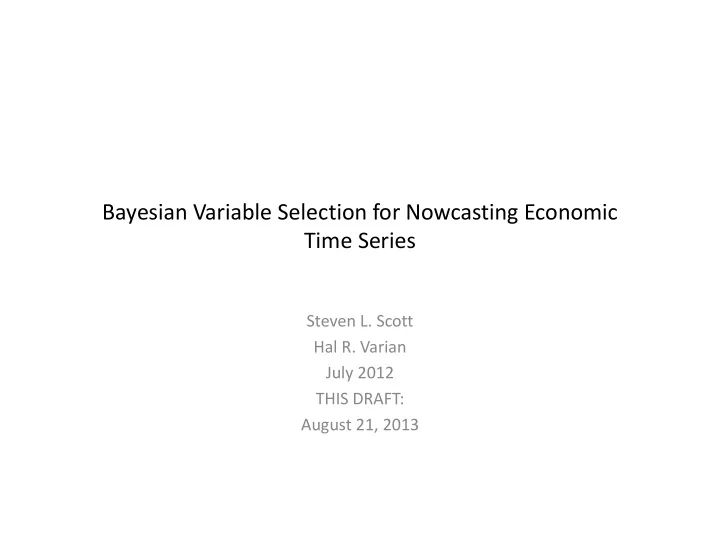

Bayesian Variable Selection for Nowcasting Economic Time Series Steven L. Scott Hal R. Varian July 2012 THIS DRAFT: August 21, 2013
Introduction • Hal R. Varian (2010) Computer Mediated Transactions , The American Economic Review Classifies impact of computer mediated transactions into four main categories: o New forms of contract; • More information => allows more efficient contracts in an insurance contract: Putting a computer transmitter in the trunk of the car that records the vehicle's speed o Enable experimentation; • The ads team at Google ran a number of experiments, tweaking everything from the background color of the ads, to the spacing between the ads, which resulted in a number of changes in the system. o Facilitate personalization and customization; • Instead of a “one size fits all” model, the web offers a “market of one .” Amazon , for example, makes suggestions of things to buy based on your previous purchases, or on purchases of consumers like you. o Facilitate data extraction and analysis; • Choi and Varian (2009b) and Choi and Varian (2009a) use real-time publicly available search engine data to predict the current level of economic activity for automobile, real estate, retail trade, travel, and unemployment indicators. • The last one is the subject of current working paper: Bayesian Variable Selection for Nowcasting Economic Time Series • Clements and Hendry (2003) and Castle and Hendry (2009) have coined the term “ nowcasting ” to describe the use of real-time data to estimate the current state of the economy. 2
Introduction • Our motivating examples for this work is Google Trends, a system that produces an index of search activity on queries entered into Google. 120 100 لبط رلبد 80 60 40 20 0 3
4
Introduction • The data is normalized. o Canada and Fiji show the same percentages for the term 'hotel.' This means that they have the same amount of search volume for that term. o New York doesn't appear on the list for the term 'haircut.' This does not mean that people in New York don't search for this term at all. They • don't use Google to find a barber or hair salon. • use a different term for haircut-related searches • search for so many other topics unrelated to haircuts, that searches for haircut comprise a small portion of the search volume from New York as compared to other regions • The data is scaled. o The data is displayed on a scale of 0 to 100. • Google: A rising line usually indicates a growth in the term's popularity . • In Iran?! I don’t know. 5
Introduction • In previous studies, the researchers selected predictors using their judgment of relevance to the particular prediction problem. • For example, it seems natural that search engine queries in the “Vehicle Shopping” category would be good candidates for forecasting automobile sales while queries such as “file for unemployment” would be useful in forecasting initial claims for unemployment benefits. • One difficulty of human judgment: o Fat regression 6
Econometrics Model • Our approach combines three statistical methods into an integrated system we call Bayesian Structural Time Series: A “basic structural model” for trend and seasonality, estimated using Kalman Filters; o o Spike and slab regression for variable selection; o Bayesian model averaging over the best performing models for the final forecast. • The Kalman Filter, spike-and-slab prior, and model averaging all have natural Bayesian interpretations and tend to play well together. 7
Nowcasting consumer sentiment • A statistical measurement and economic indicator of the overall health of the economy as determined by consumer opinion. Consumer sentiment takes into account an individual's feelings toward his or her own current financial health, the health of the economy in the short term and the prospects for longer term economic growth. • We use the University of Michigan monthly survey of Consumer Sentiment from January 2004-April 2012. • Our data from Google Trends starts at January 2004, and our sample ends in April 2012, giving us 100 observations. • For predictors, we use 151 categories from Google Trends that have some connection with economics. These potential predictors were chosen from the roughly 300 query categories using the authors' judgment. • We first deseasonalize the data by using the R command stl. • We then detrend the predictors by regressing each predictor on a simple time trend. 8
Nowcasting consumer sentiment • Posterior inclusion probability (PIP) for the top 5 predictors • White bar means positive effect • Black bar means negative effect • PIP: the proportion of the estimated models in which that predictor was present. 9
Nowcasting consumer sentiment • One step ahead forecasts along with the actual observations. • The model predicts reasonably well with a mean absolute one-step- ahead prediction error of about 4.5%. • A naive AR(1) model has a mean absolute one-step- ahead prediction error of 5.2%, indicating an improvement of about 14%. 10
• رکشت اب 11
Recommend
More recommend